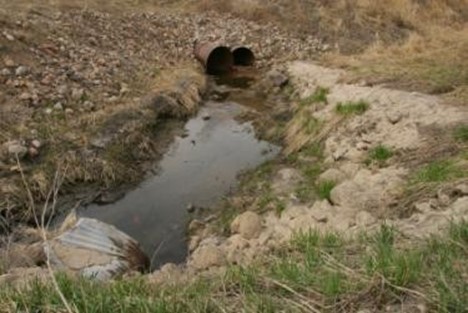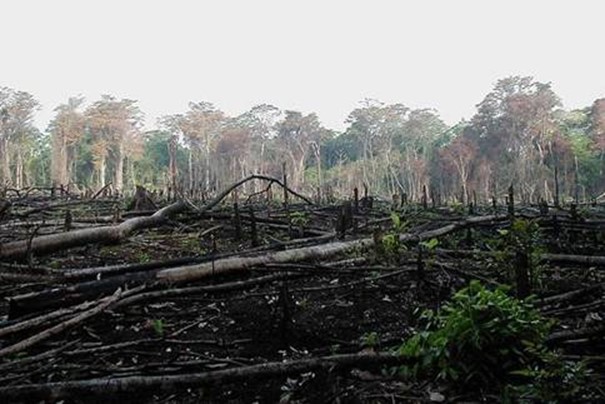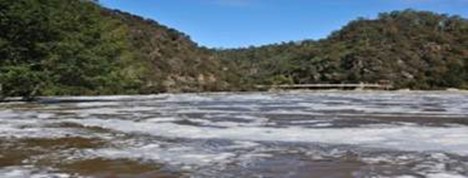AGRICULTURE AND ENVIRONMENTAL MANAGEMENT
Environmental degradation
Environmental degradation is the deterioration of the environment through depletion of resources such as air, water and soil; the destruction of ecosystems and the extinction of wildlife. It is defined as any change or disturbance to the environment perceived to be deleterious or undesirable. As indicated by the I=PAT equation, environmental impact (I) or degradation is caused by the combination of an already very large and increasing human population (P), continually increasing economic growth or per capita affluence (A), and the application of resource depleting and polluting technology (T).
Environmental degradation is one of the ten threats officially cautioned by the High-level Panel on Threats, Challenges and Change of the United Nations. The United Nations International Strategy for Disaster Reduction defines environmental degradation as “The reduction of the capacity of the environment to meet social and ecological objectives, and needs”. Environmental degradation is of many types. When natural habitats are destroyed or natural resources are depleted, the environment is degraded. Efforts to counteract this problem include environmental protection and environmental resources management.

Water degradation
One major component of environmental degradation is the depletion of the resource of fresh water on Earth. Approximately only 2.5% of all of the water on Earth is fresh water, with the rest being salt water. 69% of the fresh water is frozen in ice caps located on Antarctica and
Greenland, so only 30% of the 2.5% of fresh water is available for consumption. Fresh water is an exceptionally important resource, since life on Earth is ultimately dependent on it. Water transports nutrients and chemicals within the biosphere to all forms of life, sustain both plants and animals, and mould the surface of the Earth with transportation and deposition of materials.
The current top three uses of fresh water account for 95% of its consumption; approximately 85% is used for irrigation of farmland, golf courses, and parks, 6% is used for domestic purposes such as indoor bathing uses and outdoor garden and lawn use, and 4% is used for industrial purposes such as processing, washing, and cooling in manufacturing centers. It is estimated that one in three people over the entire globe are already facing water shortages, almost one-fifth of the world’s population live in areas of physical water scarcity, and almost one quarter of the world’s population live in a developing country that lacks the necessary infrastructure to use water from available rivers and aquifers. Water scarcity is an increasing problem due to many foreseen issues in the future, including population growth, increased urbanization, higher standards of living, and climate change.
Climate change and temperature
Climate change affects the Earth’s water supply in a large number of ways. It is predicted that the mean global temperature will rise in the coming years due to a number of forces affecting the climate, the amount of atmospheric CO2 will rise, and both of these will influence water resources; evaporation depends strongly on temperature and moisture availability, which can ultimately affect the amount of water available to replenish groundwater supplies.
Transpiration from plants can be affected by a rise in atmospheric CO2, which can decrease their use of water, but can also raise their use of water from possible increases of leaf area. Temperature increase can decrease the length of the snow season in the winter and increase the intensity of snowmelt in warmer seasons, leading to peak runoff of snowmelt earlier in the season, affecting soil moisture, flood and drought risks, and storage capacities depending on the area.
Warmer winter temperatures cause a decrease in snow pack, which can result in diminished water resources during summer. This is especially important at mid-latitudes and in mountain regions that depend on glacial runoff to replenish their river systems and groundwater supplies, making these areas increasingly vulnerable to water shortages over time; an increase in temperature will initially result in a rapid rise in water melting from glaciers in the summer, followed by a retreat in glaciers and a decrease in the melt and consequently the water supply every year as the size of these glaciers get smaller and smaller.
Thermal expansion of water and increased melting of oceanic glaciers from an increase in temperature gives way to a rise in sea level, which can affect the fresh water supply of coastal areas as well; as river mouths and deltas with higher salinity get pushed further inland, an intrusion of saltwater results in an increase of salinity in reservoirs and aquifers. Sea-level rise may also consequently be caused by a depletion of groundwater, as climate change can affect the hydrologic cycle in a number of ways. Uneven nglish-swahili/distribution” target=”_blank”>distributions of increased temperatures and increased precipitation around the globe results in water surpluses and deficits, but a global decrease in groundwater suggests a rise in sea level, even after melt water and thermal expansion were accounted for, which can provide a positive feedback to the problems sea-level rise causes to fresh-water supply.
A rise in air temperature results in a rise in water temperature, which is also very significant in water degradation, as the water would become more susceptible to bacterial growth. An increase in water temperature can also affect ecosystems greatly because of a species’ sensitivity to temperature, and also by inducing changes in a body of water’s self-purification system from decreased amounts of dissolved oxygen in the water due to rises in temperature.
Causes of Environmental Degradation
The primary cause of environmental degradation is human disturbance. The degree of the environmental impact varies with the cause, the habitat, and the plants and animals that inhabit it.
Habitat Fragmentation
Habitat fragmentation carries long term environmental impacts, some of which can destroy entire ecosystems. An ecosystem is a distinct unit and includes all the living and non-living elements that reside within it. Plants and animals are obvious members, but it will also include other components on which they rely on such as streams, lakes, and soils.
Habitats become fragmented when development breaks up solid stretches of land. Examples include roads which may cut through forests or even trails which wind through prairies. While it may not sound all bad on the surface, there are serious consequences. The largest of these consequences are initially felt by specific plant and animal communities, most of which are specialized for their bioregion or require large areas of land to retain a healthy genetic heritage.
Area Sensitive Animals
Some wildlife species require large stretches of land in order to meet all of their needs for food, habitat, and other resources. These animals are called area sensitive. When the environment is fragmented, the large patches of habitat no longer exist. It becomes more difficult for the wildlife to get the resources they to survive, possibly becoming threatened or endangered. The environment suffers without the animals that play their role in the food web.
Aggressive Plant Life
A more critical result of habitat fragmentation is land disturbance. Many weedy plant species, such as garlic mustard and purple loosestrife, are both opportunistic and invasive. A breach in the habitat gives them an opportunity to take hold. These aggressive plants can take over an environment, displacing the native flora. The result is habitat with a single dominant plant which doesn’t provide adequate food resources for all the wildlife. Entire ecosystems are threatened with extinction, according to the National Resources Defense Council.
Some weeds are so invasive and aggressive that they are declared noxious by the federal or state governments to prevent them from destroying unspoiled areas. The cultivation or even the sale of noxious weeds is prohibited by law.
Human Sources of Environmental Deterioration
Humans and their activities are a major source of environmental degradation.
Water and Air Pollution
Water and air pollution are unfortunately the common causes of environmental degradation. Pollution introduces contaminants into the environment that can maim or even kill plant and animal species. The two often go hand in hand.
Acid Rain
Acid rain occurs when sulfur dioxide from coal plant emissions combines with moisture present in the air. A chemical reaction creates this acid precipitation. Acid rain can acidify and pollute lakes and streams. It causes similar effects to the soil. According to the U.S. Environmental Protection Agency (EPA), if enough acid rain falls in a given environment, it can acidify the water or soil to a point where no life can be sustained. Plants die off. The animals that depend upon them disappear. The condition of the environment deteriorates.
Agricultural Runoff

Farming creates agriculture runoff issues.
Agricultural runoff is a deadly source of pollutants which can degrade environments, so much so that the EPA identifies agriculture as the primary source of water pollution.
Surface water washes over the soil and into lakes and streams. When it does so, it carries the fertilizers and pesticides used on the farm lands into water resources. Introducing poisons into waterways will have dire consequences. Fertilizers, whether or not they are organic, carry equal risks.
Fertilizers containing large amounts of phosphorus can cause explosions of algae in lakes. As the algae die, bacteria start to breakdown the organic material. It soon develops into a situation where bacteria are using up the available dissolved oxygen in the water. Plants, fish, and other organisms begin to die off. The water becomes acidic. Like acid rain, lakes become dead zones with conditions so toxic that neither plants nor animals can live in these environments.
Urban Development
According to many noted ecologists, including those at Cornell University, urban development is one of the primary causes of environmental degradation. As populations increased, so did the need for land for homes and farms. Wetlands were drained. Prairies were plowed over. Today, less than 50 percent of the nation’s wetlands still exist, according to the North Carolina State University Water Quality Group. National Geographic states that only five percent of the native prairie remains.
Environmental degradation is one of most urgent of environmental issues. Depending upon the damage, some environments may never recover. The plants and animals that inhabited these places will be lost forever. In order to reduce any future impacts, city planners, industry, and resource managers must consider the long term effects of development on the environment. With sound planning, future environmental degradation can be prevented.

Environmental issues can be seen by long term ecological effects, some of which can demo lish whole environments. An environment is a unique unit and incorporates all the living and non-living components that live inside it. Plants and creatures are evident parts of the environment, but it also includes the things on which they depend on, for example, streams, lakes, and soils.
Environmental surroundings get to be divided when technological advancement splits up areas of land. Some examples of this can include streets which may slice through woods or even trails which wind through prairies. While it may not sound all terrible on the surface, there are bad results. The biggest of these results are felt by particular animal and plant groups, the vast majority of which are specific for their bio-region or need a large area in order to make sure that their genetic lines are kept intact.
Natural Causes

Mother Nature causes environmental problems, too.
While environmental degradation is most commonly associated with the activities of humans, the fact is that environments are also constantly changing over time. With or without the impact of human activities, some ecosystems degrade over time to the point where they cannot support the life that is “meant” to live there.
Things like landslides, earthquakes, tsunamis, hurricanes, and wildfires can completely decimate local plant and animal communities to the point where they can no longer function. This can either come about through physical destruction via natural disaster or by the long-term degradation of resources by the introduction of an invasive alien species to a new habitat. The latter often occurs after hurricanes, when lizards and insects are washed across small stretches of water to foreign environments. Sometimes, the environment cannot keep up with the new species, and degradation can occur.
Causes of Environmental Degradation
Some environmental life species require substantial areas to help provide food, living space, and other different assets. These creatures are called area specific. At the point when the biome is divided, the vast patches of living space don’t exist anymore. It gets to be more troublesome for the wildlife to get the assets they need in order to survive. The environment goes on, even though the animals and plant life are not there to help sustain it properly.
1. Land Disturbance: A more basic cause of environmental degradation is land damage. Numerous weedy plant species, for example, garlic mustard, are both foreign and obtrusive. A rupture in the environmental surroundings provides for them a chance to start growing and spreading. These plants can assume control over nature, eliminating the local greenery. The result is territory with a solitary predominant plant which doesn‟t give satisfactory food assets to all the environmental life. Whole environments can be destroyed because of these invasive species.
2. Pollution: Pollution, in whatever form, whether it is air, water, land or noise is harmful for the environment. Air pollution pollutes the air that we breathe which causes health issues. Water pollution degrades the quality of water that we use for drinking purposes. Land pollution results in degradation of earth’s surface as a result of human activities. Noise pollution can cause irreparable damage to our ears when exposed to continuous large sounds like honking of vehicles on a busy road or machines producing large noise in a factory or a mill.
3. Overpopulation: Rapid population growth puts strain on natural resources which results in degradation of our environment. Mortality rate has gone down due to better a medical facility which has resulted in increased lifespan. More population simple means more demand for food, clothes and shelter. You need more space to grow food and provide homes to millions of people. This results in deforestation which is another factor of environmental degradation.